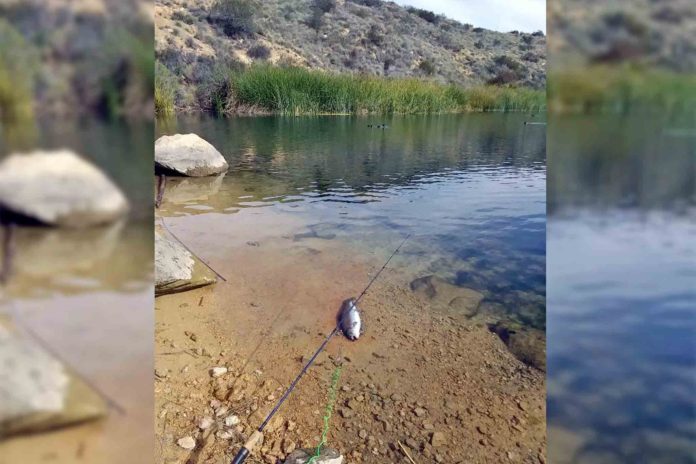Another day at Dixon Lake, another fat three-pound rainbow trout for the smoker.
Dock Totals 1/9 – 1/15: 578 anglers aboard 31 half-day to 1.5-day trips out of San Diego landings this past week caught 8 blacksmith perch, 36 bluefin tuna (up to 100 pounds), 2 blue perch, 71 calico bass (50 released), 43 halfmoon, 1 halibut, 52 lingcod, 125 lobster (86 released), 975 rockfish, 275 sand bass, 596 sculpin, 4 triggerfish, and 119 yellowtail.
Saltwater: While a bit of bluefin tuna action outside of Cedros Island is keeping the attention of a few boats still operating 1.5 to 3-day runs south, the coastal Baja yellowtail action has been warming back up. After a bit of a lull, the bruiser jacks returned in force to nearshore waters outside of San Quintin, and continue their seasonal bite from Santa Rosalillita, around Punta Eugenia, and on down to the southern end of the Vizcaino Peninsula. There have been a lot of good-sized fish caught by friends off Quintin and down south, some fish coming in near the 50-pound mark. While the Pacifica had a rough day on bluefin with only 4 landed for their 22 anglers aboard a 1.5-day trip, the Polaris Supreme reported 36 fish landed up to 100 pounds during their 3-day run with 24 anglers. 13 anglers aboard the Pacific Voyager 2.5-day trip concentrated on the rockfish and yellowtail bite nearer the Baja coast and scored well, with 119 yellowtail, 60 rockfish, and 52 lingcod coming over the rail.
Further down the line, yellowfin tuna to over 200 pounds are showing for the long-range fleet fishing the Ridge and out at Alijos Rocks, with all signs being good for that excellent fishing to continue. In our nearshore waters, it’s all about the bass- as in sand bass. Though the calico bite has been hit and miss depending on current, the sand bass bite, especially of the Point Loma flats down to the Imperial Beach ‘pipe’, has been consistently good, with most of the fish caught measuring over 14 inches. Rockfish are biting well for the boats venturing south of the border to the lower 9-Mile Bank and other high spots within half to full-day reach in Mexican waters.
In the surf, halibut are biting on occasion, and along with surf perch are providing another winter off-season outlet for anglers targeting them. Forget sand crabs for bait, they’ve moved deep as is their wintertime normal. Try crank baits like Lucky Crafts or Gulp sandworms, grubs, and even their imitation sand crab baits for action. The best times are when tides are moderate, surf is low to medium, and the bottom of the tide to hit holes hard to reach and fish to the top as the tide rises.
Freshwater: It’s all about the trout this past week, even though winter bass fishing has been decent. But, and given taste is subjective, those stocked trout are edible and preferred table-fare to green bass. I have been a few times in recent weeks, and I am zoning in on the most productive methods for trout. Although it does make a difference how many days before fishing, they were stocked, there are the common go-to baits when targeting trout. Topping that list is chartreuse Power Bait, especially with glitter. I like to present it on a long 24-inch to 30-inch leader with a weight just heavy enough to get a decent cast. As the stocked fish tend to circle the lakes and coves near to the shore, one doesn’t have to cast much more than a couple dozen yards, and usually less.
I have soaked worms, specifically nightcrawlers directly in front of trout by sight, and so far, no takers. Meal worms might get them to go, but I haven’t yet tried those, though I do know trout favor them. Other popular trout baits may be restricted at area lakes, like corn, so be sure to check bait limitations before heading out to fill your creel.
For lures, my go-to Kastmasters, small spoons like Thomas Buoyant, tiny Krokodiles, and spinners like Roostser Tails and Mepps have all done little to encourage tank-raised trout into biting. I have noticed that guys working a 1/32nd ounce mini jig, mostly white or yellow, where trout are congregating have done very well. In the time I caught one 3-pound trout soaking Power Bait, one angler fishing the same cove caught six fish using mini jigs. Alas, I had none in the box, so I just enjoyed watching him catch. This also brings me to line size. I was fishing 6-pound test, which is on the heavy side of what is working. The guy with the mini jigs was using 2-pound line. Though he was the ‘catchinist’ angler in the cove, he released 4 of them unintentionally as they broke the line when the fish fought hard at the bank. My advice is center around 4-pound test, fish power bait or mini jigs (in white, seconded by yellow), and, to secure the frantic hooked fish, take a long-handled net. Some of these stocked trout are up to and over 8 pounds and require a bit of finesse to not only hook, but to land.
Trout fight very hard once at the shoreline. They sense their end, however deep their senses run. I do know that migrating white pelicans are hunting them along shore and have seen a few get scooped up. Two ospreys were also working Whisker Cove at Dixon while I was there. Birds beat the fish up in the shallows, where the trout tend to cruise for days after being planted, which is apparently what they do in tanks where they are raised. Every fish caught would draw two or three pelicans that would fly over and watch the action. White pelicans, however, do not ‘plunge dive’ from high up as our native brown pelicans do. White pelicans swim in groups of three or more and try to herd fish to a point where they can plunge their heads and scoop up fish in quick thrusts. Were they the diving type we see at our local bays and beaches, the trout would not stand a chance. So far, it seems our diving brown pelicans haven’t figured out the freshwater action in San Diego County lakes during the wintertime. Raptors, on the other hand, find the trout stocking quite appetizing and golden eagles, bald eagles, and ospreys all take part in feeding on them. Go get some!
Fish Plants: January 24 – Lake Jennings, trout (1,500), January 25 – Dixon Lake, trout (1,500), January 27 – Lake Poway, trout (1,500)
Credit: Source link































